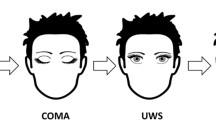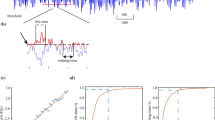Abstract
Temporal fluctuations of cognitively-mediated behaviors in minimally conscious state (MCS) have been linked to changes of awareness, but the time-pattern of these variations remains ill-described. We analyzed 4-h EEG recordings from 12 patients with disorders of consciousness (6 MCS and 6 vegetative state/unresponsive wakefulness syndrome, VS/UWS). Relative powers (delta, theta, alpha, beta1 and beta2 bands) and spectral entropy were estimated (Fz, Cz and Pz derivations). Spectral entropy time-courses were then analyzed. MCS patients had higher theta and alpha and lower delta power when compared to VS/UWS. They showed higher spectral entropy mean value and higher time variability. MCS patients were characterized by spectral entropy fluctuations with periodicities of 70 min (range 57–80 min). Notably, these periodicities closely resemble those described in awake healthy subjects, which were hypothesized to be related to fluctuation in vigilance/attention. No significant periodicity was observed for VS/UWS. The spectral entropy periodicity found in MCS patients could reflect the fluctuation of awareness responsible for the inconsistency of MCS manifestation of cognitively-mediated behaviors. The presence of a 70 min periodicity in spectral entropy could permit clinicians to better choose their time-window when performing a clinical assessment of consciousness. It could also permit to monitor fluctuations in cognitive performance (i.e., response to command) during complementary testing by passive or active electrophysiological or functional neuroimaging paradigms or in resting state conditions.






Similar content being viewed by others
References
Laureys S, Celesia GG, Cohadon F, Lavrijsen J, León-Carrión J, Sannita WG, Sazbon L, Schmutzhard E, von Wild KR, Zeman A, Dolce G, Force European Task, on Disorders of Consciousness (2010) Unresponsive wakefulness syndrome: a new name for the vegetative state or apallic syndrome. BMC Med 8:68
Giacino JT, Ashwal S, Childs N, Cranford R, Jennett B, Katz DI, Kelly JP, Rosenberg JH, Whyte J, Zafonte RD, Zasler ND (2002) The minimally conscious state, definition and diagnostic criteria. Neurology 58:349–353
Bruno MA, Vanhaudenhuyse A, Thibaut A, Moonen G, Laureys S (2011) From unresponsive wakefulness to minimally conscious PLUS and functional locked-in syndromes: recent advances in our understanding of disorders of consciousness. J Neurol 258:1373–1384
Majerus S, Bruno MA, Schnakers C, Giacino JT, Laureys S (2009) The problem of aphasia in the assessment of consciousness in brain-damaged patients. Prog Brain Res 177:49–61
Giacino JT, Fins JJ, Laureys S, Schiff ND (2014) Disorders of consciousness after acquired brain injury: the state of the science. Nat Rev Neurol 10:99–114
Kotchoubey B, Vogel D, Lang S, Müller F (2014) What kind of consciousness is minimal? Brain Inj 28:1156–1163
Monti MM, Laureys S, Owen AM (2010) The vegetative state. BMJ 341:c3765
Giacino JT, Kalmar K, Whyte J (2004) The JFK Coma Recovery Scale-Revised: measurement characteristics and diagnostic utility. Arch Phys Med Rehabil 85:2020–2029
Seel RT, Sherer M, Whyte J, Katz DI, Giacino JT, Rosenbaum AM, Hammond FM, Kalmar K, Pape TL, Zafonte R, Biester RC, Kaelin D, Kean J, Zasler N (2010) Assessment scales for disorders of consciousness: evidence-based recommendations for clinical practice and research. Arch Phys Med Rehab 91:1795–1813
Monti MM, Vanhaudenhuyse A, Coleman MR, Boly M, Pickard JD, Tshibanda L, Owen AM, Laureys S (2010) Willful modulation of brain activity in disorders of consciousness. N Engl J Med 362:579–589
Laureys S, Schiff ND (2012) Coma and consciousness: paradigms (re)framed by neuroimaging. Neuroimage 61:478–491
Gosseries O, Zasler ND, Laureys S (2014) Recent advances in disorders of consciousness: focus on the diagnosis. Brain Inj 28:1141–1150
Gosseries O, Di H, Laureys S, Boly M (2014) Measuring consciousness in severely damaged brains. Annu Rev Neurosci 37:457–478
Mahon P, Greene BR, Lynch EM, McNamara B, Shorten GD (2008) Can state or response entropy be used as a measure of sleep depth? Anaesthesia 63:1309–1313
Vanluchene AL, Vereecke H, Thas O, Mortier EP, Shafer SL, Struys MM (2004) Spectral entropy as an electroencephalographic measure of anesthetic drug effect: a comparison with bispectral index and processed midlatency auditory evoked response. Anesthesiology 101:34–42
Gosseries O, Schnakers C, Ledoux D, Vanhaudenhuyse A, Bruno MA, Demertzi A, Noirhomme Q, Lehembre R, Damas P, Goldman S, Peeters E, Moonen G, Laureys S (2011) Automated EEG entropy measurements in coma, vegetative state/unresponsive wakefulness syndrome and minimally conscious state. Funct Neurol 26:25–30
Cologan V, Drouot X, Parapatics S, Delorme A, Gruber G, Moonen G, Laureys S (2013) Sleep in the unresponsive wakefulness syndrome and minimally conscious state. J Neurotrauma 30:339–346
Manly BJF (2006) Randomization, bootstrap and Monte Carlo methods in biology, 3rd edn. Chapman & Hall/CRC, London
Benjamini Y, Yekutieli D (2001) The control of the false discovery rate in multiple testing under dependency. Ann Statist 29:1165–1188
Torrence C, Compo GP (1998) A practical guide to wavelet analysis. B Am Meteorol Soc 79:61–78
Shapiro SS, Wilk MB (1965) An analysis of variance test for normality (complete samples). Biometrika 52:591–611
Sitt JD, King JR, El Karoui I, Rohaut B, Faugeras F, Gramfort A, Cohen L, Sigman M, Dehaene S, Naccache L (2014) Large scale screening of neural signatures of consciousness in patients in a vegetative or minimally conscious state. Brain 137:2258–2270
Lehembre R, Bruno MA, Vanhaudenehuyse A, Chatelle C, Cologan V, Leclerq Y, Soddu A, Macq B, Laureys S, Noirhomme Q (2012) Resting-state EEG study of comatose patients: a connectivity and frequency analysis to find differences between vegetative and minimally conscious states. Funct Neurol 27:41–47
Williams ST, Conte MM, Goldfine AM, Noirhomme Q, Gosseries Q, Thonnard M, Beattie B, Hersh J, Katz DI, Victor JD, Laureys S, Schiff ND (2013) Common resting brain dynamics indicate a possible mechanism underlying zolpidem response in severe brain injury. ELife 2:e01157
Carboncini MC, Piarulli A, Virgillito A, Arrighi PA, Andre P, Tomaiuolo F, Frisoli A, Bergamasco M, Rossi B, Bonfiglio L (2014) A case of post-traumatic minimally conscious state reversed by midazolam: clinical aspects and neurophysiological correlates. Restor Neurol Neuros 32:767–787
Cruse D, Thibaut A, Demertzi A, Nantes JC, Bruno MA, Gosseries O, Vanhaudenhuyse A, Bekinschtein TA, Owen AM, Laureys S (2013) Actigraphy assessments of circadian sleep-wake cycles in the vegetative and minimally conscious states. BMC Med 11:18
Tsuji Y, Kobayashi T (1988) Short and long ultradian EEG components in daytime arousal. Electroen Clin Neuro 70:110–117
Laureys S (2007) Eyes open, brain shut. Sci Am 296:84–89
Kleitman N (1961) The nature of dreaming. In: Wolstenholme GEW, O’Connor M (eds) The nature of sleep. Churchill, London, pp 349–364
Kleitman N (1982) Basic rest-activity cycle–22 years later. Sleep 5:311–317
Okawa M, Matousek M, Petersén I (1984) Spontaneous vigilance fluctuations in the daytime. Psychophysiology 21:207–211
Manseau C, Broughton RJ (1984) Bilaterally synchronous ultradian EEG rhythms in awake adult humans. Psychophysiology 21:265–273
Kinomura S, Larsson J, Gulyás B, Roland PE (1996) Activation by attention of the human reticular formation and thalamic intralaminar nuclei. Science 271:512–515
Saper CB, Scammell TE, Lu J (2005) Hypothalamic regulation of sleep and circadian rhythms. Nature 437:1257–1263
Schiff ND (2008) Central thalamic contributions to arousal regulation and neurological disorders of consciousness. Ann NY Acad Sci 1129:105–118
Thibaut A, Bruno MA, Ledoux D, Demertzi A, Laureys S (2014) tDCS in patients with disorders of consciousness: sham-controlled randomized double-blind study. Neurology 82:1112–1118
Acknowledgments
No external funding was used for the study.
Author information
Authors and Affiliations
Corresponding author
Ethics declarations
Conflicts of interest
None of the authors have potential conflicts of interest to be disclosed.
Ethical standards
The study was approved by the Ethics Committee of the Faculty of Medicine of the University of Liège. Written informed consent forms were received from the patients' legal representatives. The study was conducted in agreement with the Declaration of Helsinki 1964 and its later amendments.
Additional information
O. Gosseries and S. Laureys contributed equally to this work.
Electronic supplementary material
Below is the link to the electronic supplementary material.
Rights and permissions
About this article
Cite this article
Piarulli, A., Bergamasco, M., Thibaut, A. et al. EEG ultradian rhythmicity differences in disorders of consciousness during wakefulness. J Neurol 263, 1746–1760 (2016). https://doi.org/10.1007/s00415-016-8196-y
Received:
Revised:
Accepted:
Published:
Issue Date:
DOI: https://doi.org/10.1007/s00415-016-8196-y




